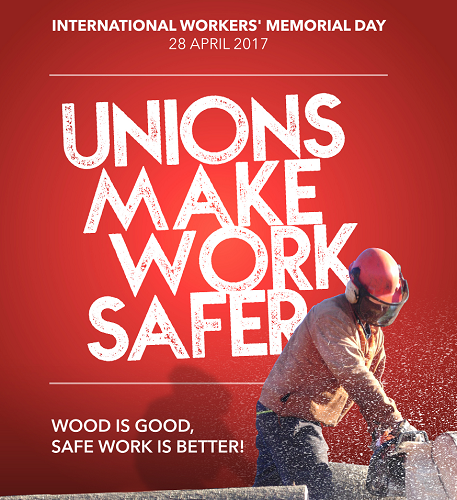

“Unions Make Work Safer!” is the slogan for International Workers’ Memorial Day on 28 April 2017.
Unions Make Work Safer! The case of forestry was written by BWI (Building and Wood Worker’s International)
“Forestry work does not compare to factory or construction work and it presents its own sets of challenges and problems in terms of Occupational Health and Safety (OSH). However, BWI affiliates in the sector work hard every day to minimize the risks of forestry work and make sure that OSH trainings and provisions are put in place.” says BWI General Secretary Ambet Yuson:
The BWI has been supporting and working with forestry and wood workers for many years. Based on experience and empirical evidence from the ground, BWI has observed a strong correlation between labour abuses and environmental damages in the forestry and wood sectors. Therefore Yuson adds: “Wood is good, Safe Work is better!”
In the forestry sector, the outdoor work environment exposes workers to natural and man-made hazards. Workers are exposed to the extremes of weather: heat, cold, snow, rain and ultraviolet radiation. In extreme hot weather, workers pass out. Depending on the region of the world, there are also threats from wildlife, for example, poisonous insects, snakes and mammals such as tigers and bears. Other natural hazards include broken terrain or mud, dense vegetation and other biological agents. Work even continues despite bad weather and in mechanized operations, it continues during the night.
Worksites tend to be in remote areas, with poor communication and difficulties in rescue and evacuation. Life in camps for extended periods of isolation from family and friends continue to be a common practice in some countries. There are also risks in terms of felling and yarding of trees as there could be equipment failure. In addition, rigging operators are frequently out of sight from the choker setter communications. The pace of work is probably the most dangerous across all environments. In some countries, workers are paid by volume which makes workers run from one tree to the next raising the risk of accidents.
In plywood plants there are chemical hazards from glue and other heated adhesives. In places where formaldehyde, a colour-less, flammable, strong-smelling chemical, is still used in building materials, cancer and respiratory illness are common. In all environments saw dust is a problem. Some species of trees have cancer producing dust, others just have particulate issues which affect the breathing system of workers.
Occupational Health and Safety is a team effort: it requires constant interaction between employers, governments and workers. Trade unions have been fundamental in driving the OSH agenda and making sure that workplaces are sound for workers.